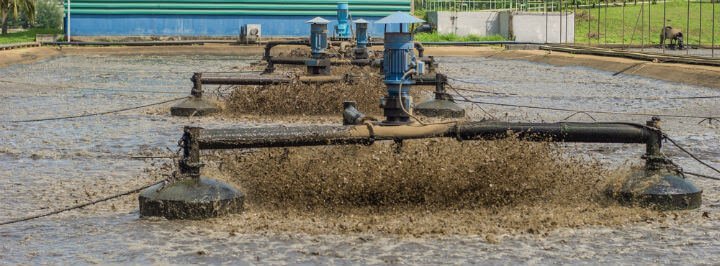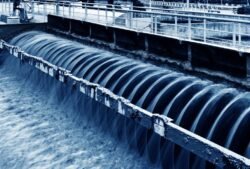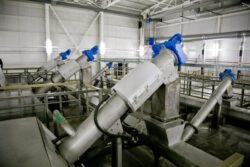
Activated Sludge Process in Wastewater Treatment: An Efficient Biological Methodology

The Activated Sludge Process is a critical part of modern wastewater treatment methods. Through this process, wastewater containing organic matter is aerated in a basin to encourage the growth of microorganisms that consume the organic pollutants. The method vastly improves the quality of the effluent, rendering it safer for discharge into natural water bodies or for further purification. Since its inception in the early 20th century, the activated sludge process has become a standard in the treatment of sewage and industrial wastewaters.
Operational expertise is essential to the success of the activated sludge process. Factors like aeration rate, sludge age, and the mix of microbial populations are carefully controlled to optimize the breakdown of organic material. Alongside these considerations, routine maintenance and troubleshooting of equipment are integral in keeping the process efficient. Advances in technology have also contributed to the refinement of this process, enhancing its effectiveness while reducing the environmental footprint of wastewater treatment.
Key Takeaways
- The activated sludge process is essential for treating the organic matter in wastewater.
- Proper operation and maintenance are key to optimizing the efficiency of the process.
- Technological advancements continue to improve the process’s sustainability and effectiveness.
Fundamentals of Activated Sludge Process
The activated sludge process is a critical part of modern wastewater treatment, utilizing controlled biological degradation of waste within an aeration basin.
Historical Development
The activated sludge process was developed in the United Kingdom in 1914. It represented a significant advancement in the treatment of wastewater, as it allowed for the efficient degradation of biological waste using aeration and a biological floc composed of bacteria and protozoa.
Basic Concepts and Definitions
At its core, the activated sludge process is a method of treating sewage and industrial wastewater using highly concentrated microbial communities. The process involves introducing air or oxygen to a mixture of wastewater and activated sludge, which is a slurry of microorganisms capable of digesting organic matter.
- Aeration Tank: A basin where sewage is aerated to maintain aerobic conditions.
- Activated Sludge: Sludge particles produced in raw or settled wastewater by the growth of organisms in aeration tanks in the presence of dissolved oxygen.
Biochemical Aspects
The biochemical transformation in the activated sludge process primarily involves the conversion of organic matter into carbon dioxide, water, and biosolids through microbial metabolism. The essential elements for this aerobic metabolic activity include oxygen, nutrients, and a diverse microbial community.
- Aerobic bacteria: Key players in oxidizing organic compounds.
- Endogenous respiration: When organic material is scarce, microorganisms consume their protoplasm.
In the activated sludge treatment, these biochemical reactions are carefully controlled to optimize the reduction of organic pollutants, ensuring the treated water can be safely discharged or reclaimed for further use.
Process Design and Operation
The design and operation of an Activated Sludge Process in Wastewater Treatment is complex, involving precise calculations and control of aeration systems, sludge retention time, oxygen requirements, and process control parameters. These factors collectively influence the effectiveness and efficiency of the treatment process.
Aeration Systems
Aeration systems provide the oxygen necessary for microorganisms to break down organic material in wastewater. Two common types exist surface aerators, which release oxygen by agitating the water surface, and subsurface diffusers, which deliver oxygen through fine bubbles from the tank bottom. The choice of system impacts the oxygen transfer efficiency and energy consumption.
Sludge Age and Retention Time
Sludge age, also known as mean cell residence time (MCRT), is the average time that activated sludge particles remain in the system. It is a critical design parameter that affects the biodegradation rates and the system’s ability to handle both organic and nutrient loads. Solids retention time (SRT) is closely managed to ensure optimal microbial activity without allowing excess biomass growth, which could lead to sludge bulking.
Oxygen Requirements and Transfer
Effective treatment hinges on adequate oxygen provision to sustain aerobic digestion. The oxygen requirement is influenced by the biochemical oxygen demand (BOD) of the incoming wastewater, the mass of the activated sludge, and the operating temperature. Engineers must ensure an efficient oxygen transfer rate, which can be achieved through design considerations like diffuser depth and spacing in aeration tanks.
Process Control Parameters
Process control in an Activated Sludge Process is about maintaining the delicate balance required for efficient wastewater treatment. Parameters such as pH, dissolved oxygen levels, and mixed liquor-suspended solids (MLSS) are constantly monitored and adjusted to maintain an environment conducive to the microorganisms. Ensuring the precise operation of these parameters minimizes operational costs while maximizing treatment quality.
Microbiology of Activated Sludge
The Activated Sludge Process is a vital component of modern wastewater treatment, relying on complex microbial communities to degrade organic pollutants. These communities consist largely of bacteria and protozoa, which perform essential functions to maintain system efficiency and reliability.
Bacteria and Protozoa
Bacteria are the backbone of the activated sludge ecosystem. They are responsible for the bulk of organic matter breakdown. A variety of bacteria types are involved, each with specific roles in the treatment process:
- Heterotrophic bacteria decompose organic compounds, converting them into energy, CO2, and water.
- Autotrophic bacteria, like Nitrosomonas and Nitrobacter, are critical for nitrification, converting ammonia to nitrite and then nitrate.
- Floc-forming bacteria promote the formation of clumps known as flocs, which settle out of the water as sludge, thereby separating from the treated effluent.
Additionally, bacteria populations are influenced by process conditions such as temperature, pH, oxygen levels, and the presence of toxic substances.
Protozoa, on the other hand, plays a secondary but crucial role in the activated sludge process. They feed on bacteria and smaller particles, leading to the clarification of the wastewater by reducing turbidity. The presence of certain protozoa can also be indicative of the overall health and operational conditions of the wastewater treatment system.
Microbial Ecosystem and Dynamics
The microbial ecosystem in activated sludge systems exhibits dynamic relationships and diversity. A small, global core bacterial community is linked to effective sludge performance, despite the presence of a high diversity of species. These communities follow a Poisson lognormal distribution in terms of abundance and are adapted to the engineered environment of the wastewater treatment plant.
Process control and optimization depend heavily on understanding the interactions within these microbial communities, as they respond to the varying conditions of the wastewater treatment process. By monitoring community composition and the presence of specific microbial populations, such as antibiotic-resistant genes, operators can make informed decisions to improve system performance and ensure that the treated water meets safety standards.
Understanding microbial dynamics is crucial for diagnosing process upsets, anticipating responses to changes in the influent, and development strategies to enhance nutrient removal and overall treatment efficiency. The microbial ecology within activated sludge systems is subject to both deterministic processes, such as selection and competition, as well as stochastic events that can influence community structure and function.
Maintenance and Troubleshooting
Maintaining the Activated Sludge Process is critical for efficient wastewater treatment. Proactive troubleshooting can prevent costly downtime and environmental non-compliance.
Common Operational Issues
Foaming and bulking are recurring complications in the activated sludge process. Foaming, often due to excessive filamentous bacteria, can cause treatment inefficiencies and overflow issues. Bulking sludge is typically characterized by poor settling due to the growth of specific microorganisms. Operators may observe an increase in the sludge volume index (SVI), indicating a bulking event.
- Nutrient Imbalance: A deficit or surplus of nutrients can lead to poor floc formation.
- Low Dissolved Oxygen (DO): Insufficient aeration can inhibit microbial activity and reduce BOD removal efficacy.
- Temperature Fluctuations: Extremes in temperature can impact bacterial metabolism and treatment performance.
Process Optimization Strategies
Optimizing the activated sludge process involves carefully balancing parameters to encourage efficient waste degradation.
- Aeration Control: Managing aeration rates to maintain optimal DO levels is paramount. This can be achieved through automated DO probes linked to blower systems.
- Sludge Wasting: Regular and strategic sludge wasting helps maintain a healthy age of microorganisms and prevents sludge bulking.
- Nutrient Dosing: Precise nutrient dosing ensures microbial populations have the macronutrients necessary for effective waste processing.
Controlling environmental factors and responding to operational cues are essential for the optimization of the activated sludge process in wastewater.
Advancements in Activated Sludge Process
The activated sludge process in wastewater treatment has seen significant enhancements, honing the efficiency and effectiveness of contaminant removal. These improvements span across technological arenas and research domains.
Technological Innovations
Technological innovations in the activated sludge process include the development of the Sequencing Batch Reactors (SBR), which perform the stages of activated sludge in timed batches, rather than continuously. This innovation allows for better control of the environmental conditions within the reactor, optimizing the treatment process. Another significant advancement is the implementation of Real-time Monitoring Systems, which use sensors and data analytics to assess wastewater parameters instantly, ensuring consistent treatment quality and faster response to process fluctuations.
Membrane Bioreactors (MBRs) represent another leap forward, combining activated sludge with membrane filtration to achieve higher-quality effluent. This technology has allowed plants to produce effluent suitable for reuse in irrigation and industrial applications, diminishing the environmental impact.
Emerging Research and Development
Emerging research and developments have been pivotal in addressing nutrient removal, energy consumption, and operational efficiency. Studies are increasingly focusing on Nitrogen and Phosphorus Removal to minimize the ecological impact of wastewater effluents as indicated by research on nitrogen cycling during wastewater treatment. The adoption of technologies serving this research, like Anammox and Enhanced Biological Phosphorus Removal (EBPR), showcases progress in the industry.
Further research is ongoing in the optimization of microbial consortia, which are crucial for the biodegradation processes within the activated sludge. Novel approaches to the selection and management of these biological communities can lead to improved breakdown of organic pollutants and operational stability.
Advancements in the activated sludge process express a continued commitment to environmental stewardship and public health through enhanced wastewater treatment.
Environmental Impact and Sustainability
The activated sludge process plays a crucial role in reducing the environmental impact of wastewater by treating and transforming harmful contaminants into treated effluent and biosolids. Its sustainability largely hinges on the effluent quality produced and the process’s overall energy consumption and carbon footprint.
Effluent Quality and Regulations
Effluent quality is a primary indicator of the activated sludge process’s environmental performance. The process is designed to meet stringent regulatory standards for water quality, ensuring that discharged water is safe for the environment and human health. The U.S. Environmental Protection Agency (EPA) sets these regulations, which mandate acceptable levels of organic and inorganic matter, nutrients, and pathogens in treated water.
- Nitrogen and Phosphorus Removal: Efficient removal of nutrients like nitrogen and phosphorus is vital to prevent eutrophication in water bodies, thereby maintaining ecological balance.
- Pathogen Reduction: A well-managed activated sludge process significantly reduces the number of pathogens, limiting public health risks.
Energy Efficiency and Carbon Footprint
The energy efficiency of the activated sludge process has a direct impact on its carbon footprint. Aeration, the heart of the process, requires significant energy input but also offers room for optimizations:
- Aeration Technology: Advances in aeration technology can lead to improved oxygen transfer efficiency, reducing energy demand and operational costs.
- Process Control: Implementing intelligent process controls can aid in making the entire operation more energy-efficient by adjusting aeration rates in response to real-time demand.
By optimizing these factors, treatment plants can drastically lower their greenhouse gas emissions, contributing positively to global efforts in combating climate change. The goal is to achieve a balance between high-quality effluent and minimal environmental impact through sustainable practices in the activated sludge process.
Frequently Asked Questions
What are the essential steps involved in the activated sludge wastewater treatment process?
In the activated sludge process, wastewater flows through several key phases: primary settling to remove physical solids, aeration where bacteria break down organic matter, then final settling to separate the clarified water from the activated sludge.
How does the activated sludge method compare with trickling filter systems in treating wastewater?
The activated sludge method often processes higher volumes of wastewater more efficiently than trickling filter systems, providing enhanced control over microbial activity and treatment conditions.
What are the main components of an activated sludge system, and how do they function?
An activated sludge system typically includes an aeration tank that fosters bacterial growth by supplying oxygen, and a secondary clarifier allowing treated water to separate from the biomass.
What are the most common types of activated sludge treatment processes used in modern wastewater facilities?
Modern facilities frequently employ variations like conventional activated sludge, extended aeration, sequencing batch reactors, and oxidation ditches, depending on treatment goals and capacity.
In the activated sludge process, how is aeration critical for the breakdown of organic matter?
Aeration supplies oxygen to bacteria in activated sludge, enabling them to effectively decompose organic matter, which is vital for reducing biochemical oxygen demand in treated water.
What maintenance practices are crucial for the optimal performance of an activated sludge wastewater treatment plant?
Maintaining optimal performance involves regular monitoring of microbial activity, proper aeration, sludge age management, and the prevention of toxic inflows that could disrupt the biological process.

